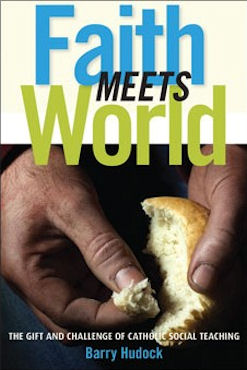
|
Posted September 26, 2013
Book: Faith Meets Word: The gift and challenge of Catholic Social Teaching Author: Barry Hudock Liguori. Liguori, Missouri. 2013. Pp. 159 An Excerpt from the Jacket:
Often called the best-kept secret in Catholicism, the principles of Catholic Social Teaching (CST) offer you a moral framework that is as ancient as the Scriptures and yet ever-new. Faith Meets World will help any Christian understand to love and serve others. In a readable and engaging style, Barry Hudock explains the historical events and Church documents that are the basis for CST. Next, he discusses its big ideas, such as human rights, solidarity, and the common good and how to put these ideas into action. Catholic Social Teaching is challenging to be sure, because it pushes you out of your comfort zone. However, it is also a priceless gift, offering a vision of a world that can be infinitely more just and loving. An Excerpt from the Book: Violence is never an option Pacifism is the conviction that violence is always wrong and a peaceful response to threats is always the right path. Though it is not at all limited to Christianity, Christian pacifists most often are not much interested in grounding their arguments in natural law or framing their convictions in nonreligious language. Their primary concern is faithfulness to the teaching and the personal example of Jesus. Who: --- taught that one must love one's neighbor and one's enemies. --- promised blessings on those who make peace. --- rejected "eye for an eye" thinking. --- when unjustly tortured and sentenced to death himself, responded only with acceptance and forgiveness. It seems that early Christians took this teaching and example seriously. There is no evidence that Christians served in the Roman army until almost the end of the second century. In the latter second century, the great Church Father Tertullian condemned Christian participation in the military and insisted that a soldier who became a Christian had to leave military service. The fourth-century conversion of the Emperor Constantine to Christianity and the subsequent integration of Christianity into the life of the empire began to change Christian attitudes about military service. Then in the fifth century came Augustine, who laid the foundation for the just-war tradition, which has been dominant ever since. Although just-war thinking has a prominent place in Catholic tradition and the Catechism of the Catholic Church includes it in its account of Catholic doctrine, it's also true that the Church has seemed to be inching closer to a pacifist position in the past half-century. Though the Second Vatican Council did acknowledge the right of a government to defend itself, it also called for "an evaluation of war with an entirely new attitude." In 1983, the bishops of the United States, in a major pastoral letter on nuclear disarmament, presented the two points of view as complementary and both valid positions for a Catholic. That was somewhat innovative. In both Evangelium Vitae and Centesimus Annus, John Paul II emphasized the importance of resolving conflict by means of nonviolent action. Perhaps most strongly, the Compendium of the Social Doctrine of the Church, in its chapter on the promotion of peace, teaches: Violence is never a proper response. With the conviction of her faith in Christ and with the awareness of her mission, the Church proclaims "that violence is evil, that violence is unacceptable as a solution to problems, that violence is unworthy of man. Violence is a lie, for it goes against the truth of our faith, the truth of our humanity. Violence destroys what it claims to defend: the dignity of the life, the freedom of human beings. War ... is never an appropriate way to resolve problems that arise between nations, ‘it has never been and it will never be because it creates new and still more complicated conflicts. Table of Contents: Part 1: Getting to know Catholic social teaching 1. What is Catholic social teaching? 2. What Mr. Newcomen started 3. Hammered out in history 4. Major documents of modern Catholic social teaching Part 2: The big ideas 5. Human dignity 6. Solidarity 7. Human rights 8. The common good 9. The universal destination of goods 10. Preferential option for the poor 11. Subsidiarity Part 3: Ideas into action 12. Family 13. Work 14. Economy 15. Politics 16. The environment 17. Peace and war 18. Life and death |
|
